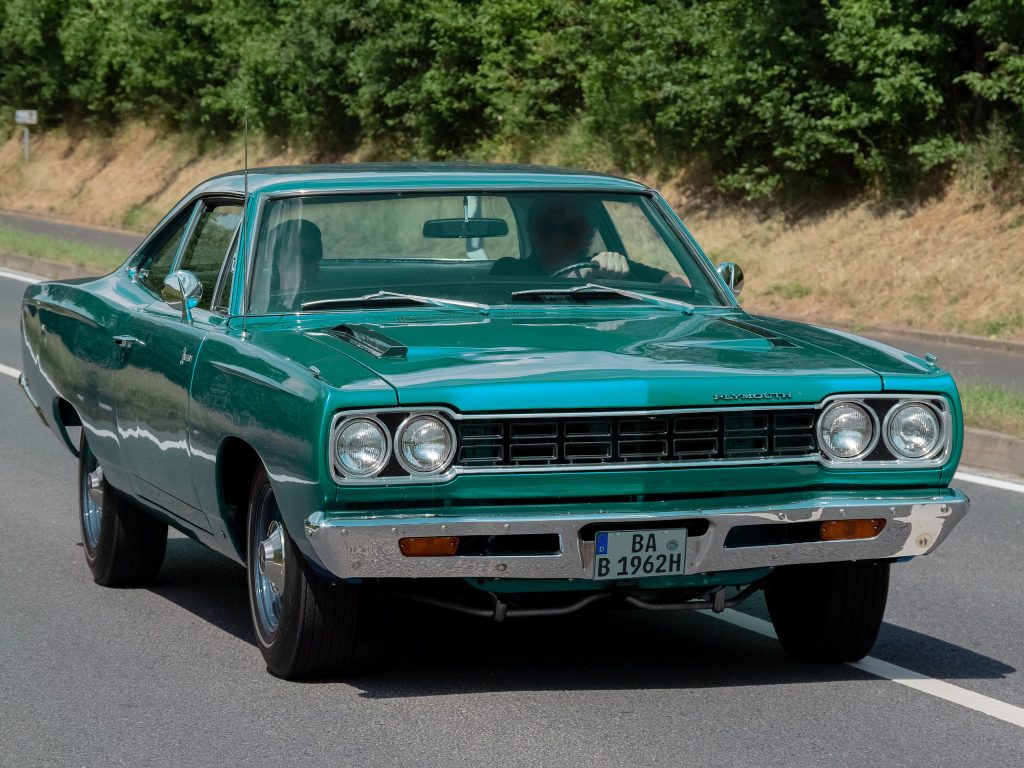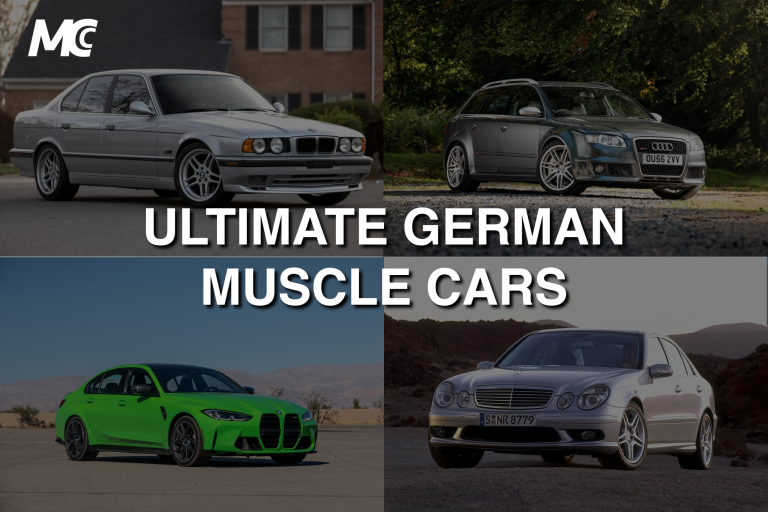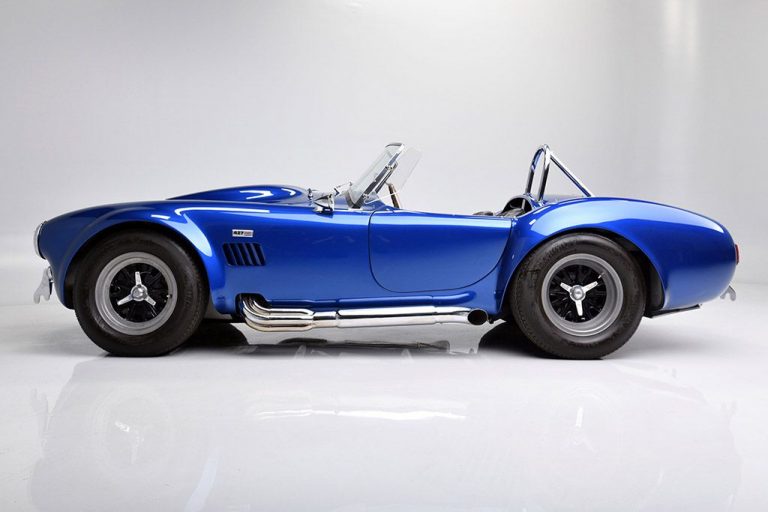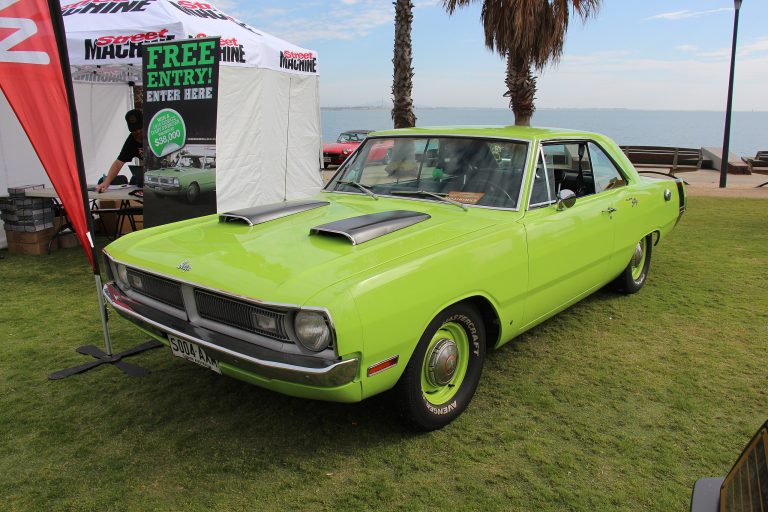Plymouth RoadRunner

Meet Chandler
Chandler has a bachelors and masters degree in history as well as a passion for classics and muscle cars. His education and historical knowledge makes him skilled at crafting highly detailed articles about America’s muscle cars and automotive history. His love of muscle cars is undeniable, with him seeking them out at every opportunity during his visits to auto shows and car meets. Chandler’s knowledge and enthusiasm towards automotive history make him a great asset to the Muscle Car Club community.
Originally introduced in 1968, the Plymouth RoadRunner defined the era of muscle. With big-block V8s, basic interiors, and heavily customizable options, the RoadRunner gave you incredible performance and value at affordable prices. The original RoadRunner only lasted until 1975, after which it became an option package for the Plymouth Volaré from 1976–1980. Still, the 1968–1971 Plymouth RoadRunners are some of the most valued muscle cars today, largely due to their engine choices. These included big-block 383, 400, and 440 cid V8 engines, as well as the iconic all-time great 426 HEMI.
Let’s learn a little more about the Plymouth RoadRunner history.
Plymouth RoadRunner Overview
The Plymouth RoadRunner lasted as a stand alone model for four generations from 1968–1975, and as a trim option for another five years until 1980, when Plymouth finally discontinued it. The name RoadRunner came from the Warner Bros. “Looney Tunes” character from the Wile E. Coyote series. Plymouth actually paid WB $50,000 for the licensing of the name, which also included an iconic “beep-beep” horn that was unique only to the Roadrunner.
The first generation RoadRunner lasted from 1968–1970, and available engines were 383, 426 (HEMI), or 440 cid big-block V8s. The most powerful was the HEMI, which made 425 horsepower and 490 lb-ft. Plymouth put the RoadRunner on the Chrysler B-body, making it look externally similar to the Dodge Charger and luxury Plymouth GTX. It was a stripped down, no-nonsense performance car, that offered extravagant horsepower without the upgraded prices.
The second generation of the Plymouth RoadRunner lasted from 1971–1974, but after strong sales in the late-’60s, the early-’70s brought decidedly less enthusiasm for the car. Due to emissions and fuel economy concerns, the RoadRunner gradually became less and less powerful. Considering the entire point of the RoadRunner was its utility as a muscle car, when the big-blocks disappeared so did its viability.
Plymouth offered one final generation of the RoadRunner for one year in 1975. They gave it a whopping nine different power options from three V8 engines, but only one of them was a big-block – which maxed out at 235 horsepower. For the next five years until 1980, the RoadRunner reverted to a trim option on the Plymouth Volaré. No engine cracked 200 horsepower, and in 1981 Plymouth dropped the RoadRunner from the lineup for good after selling less than 500 units.
1968-1970 Plymouth RoadRunner

Plymouth unveiled the first RoadRunner for the 1968 model year, and the first generation lasted until 1970. They offered the RoadRunner in two body styles, either a two-door coupe or hardtop. The RoadRunner had upgraded suspension, deluxe wheel-covers and five-spoke wheels, optional front-disc brakes, hood bulges, and F70 wide-tread “white-streak” tires. Compared with the luxury Plymouth GTX, the Roadrunner was about $5,000 cheaper ($44,000 in 2023 money).
However, when upgrading to the HEMI you had to pay $714 more, somewhat diminishing it as a cost-effective muscle car. Plymouth put the RoadRunner on the B-body, placing it as part of their Intermediate line of cars. They slotted it between the Belvedere and Satellite in terms of price and options. It had a “coke bottle” design with dual headlights, unique grille insert patterning, Also noticeable are the iconic RoadRunner cartoon emblems on the side panels and inside on the instrument panels right side.
In 1969, Plymouth added a convertible option, and that year it won the Motor Trend “Car of the Year” award. They also added the RoadRunner logo to the steering wheel, as well as bucket seats. There were several performance and track packages that beefed up suspension and cooling for track performance. A special A112 package included HEMI suspension, a fiberglass hood with locking pins that could be taken off by hand, and an air-grabber hood scoop for cooling.
Plymouth restyled the RoadRunner for 1970, including the Air Grabber hood as an option or as standard on the HEMIs. That year also included the iconic 1970 Plymouth SuperBird, which was offered for one year only. It was created to satisfy homologation purposes for NASCAR, and was based on the 1969 Dodge Charger Daytona, but with the RoadRunner shell.
1968-1970 Plymouth Roadrunner Engine Technical Specifications
| Model Years | Engine | Horsepower | Torque |
| 1968-1970 | 383 cid V8 (4bbl) | 335 horsepower | 425 lb-ft |
| 1968-1970 | 426 cid HEMI V8 (2x4bbl) | 425 horsepower | 490 lb-ft |
| 1969-1970 | 440 cid V8 (3x2bbl) | 390 horsepower | 490 lb-ft |
First Generation Engines, Transmission Options, and Performance
For the first generation of the RoadRunner, Plymouth offered three different engines. Starting in 1968, the RoadRunner could be had with either a Chrysler B-series 383 cid V8 or the all-powerful RB-series 426 cid HEMI V8. The 383 Golden Commando V8 made 335 horsepower, while the HEMI pumped out 425 horsepower and 490 lb-ft of torque.
The RoadRunner 383 got the larger 440 Super Commando’s windage tray, cylinder heads, intake manifold, and camshaft. Plymouth gave it a Carter four-barrel carburetor and low-restriction dual exhausts, and it had a 10.1:1 compression ratio. The 426 HEMI was the updated “Stage II” version, with a hot cam and 10.2:1 compression. Also included in the HEMI package were a heavy duty rear-axle, Sure-Grip differential, and K-member subframe with heavy-duty suspension. The carburetor was two four-barrels strapped together for an eight-pack behemoth.
In 1969, Plymouth decided to put an even larger big-block in the RoadRunner, giving it the 440 Super Commando six-pack. The Super Commando made 390 horsepower and 490 lb-ft of torque, slotting it between the 383 and 426. It used a six-pack carburetor, which was three Rochester double-barrel carbs strapped together to create a giant six-barrel. 1969–1970 were the top years for performance on the RoadRunner, as starting the very next year they began to decline.
When equipped with the 426 HEMI, the RoadRunner could make the ¼ pass in the low-13s, while the larger but less powerful 440 Super Commando did so in 13.5 seconds @ 109 mph. The slowest option was the 383, which did it in the 14s.
Available transmissions were a four-speed manual or optional three-speed automatic. The three-speed was the bulletproof TorqueFlite Automatic. For the most part, buyers were split pretty evenly deciding for a manual or automatic, though buyers gave the edge to the manual.
First Generation Plymouth RoadRunner Production Numbers
| Model Year | Bodystyle | Production Total (Domestic) |
| 1968 | 2-Door Coupe | 28,978 |
| 2-Door Hardtop | 15,359 | |
| 1968 Total | 44,377 | |
| 1969 | 2-Door Coupe | 33,743 |
| 2-Door Hardtop | 48,549 | |
| 2-Door Convertible | 2,128 | |
| 1969 Total | 84,420 | |
| 1970 | 2-Door Coupe | 15,716 |
| 2-Door Hardtop | 24,944 | |
| 2-Door SuperBird | 1,920 | |
| 2-Door Convertible | 824 | |
| 1970 Total | 43,404 | |
| 1968-1970 Total | 172,423 |
Sales started off well for the 1968 Plymouth RoadRunner before nearly doubling the next year in 1969. They sold just under 85,000 units in 1969, firmly establishing the RoadRunner as a viable car. However, production halved the next year in 1970 to pretty much 1968 levels, and the newly introduced convertible was extremely unpopular with buyers. Even the one-off 1970 SuperBird failed to sell well to the public, as they were almost entirely bought by dedicated racers.
1971-1974 Plymouth RoadRunner
The second generation of the Plymouth RoadRunner lasted from 1971–1974, and things were already on the decline. Engines got less powerful and both the convertible and coupe options were gone, leaving just the two-door hardtop (which was actually a coupe, too). The body styling also got reworked to the “fuselage” type design. This meant a smaller wheelbase and length, rounded contours, along with bulging side doors.
Plymouth still considered the RoadRunner part of the Satellite group of cars, and they still came with all Satellite features as standard. Separating the RoadRunner were numerous badges, deep-pile carpets, a Rallye cluster with a 150 mph speedometer, the air grabber hood, and the F70 white-streak tires.
For 1972, the grille and headlights got some minor reworkings, along with new bumpers to comply with federal requirements. Overall, the car looked pretty much the same. 1973 saw new sheet metal exterior along with a reworking of the interior for more luxury. By 1974, Plymouth was putting little into the RoadRunner, as it was much less popular after the loss of performance.
1971-1974 Plymouth RoadRunner Engine Technical Specifications
| Model Years | Engine | Horsepower | Torque |
| 1971 | 340 cid V8 (4bbl) | 275 horsepower | 340 lb-ft |
| 1971 | 383 cid V8 (4bbl) | 300 horsepower | 410 lb-ft |
| 1971 | 440 cid V8 (3x2bbl) | 385 horsepower | 490 lb-ft |
| 1971 | 426 cid HEMI V8 (2x4bbl) | 425 horsepower | 490 lb-ft |
| 1972-1973 | 340 cid V8 (4bbl) | 240 horsepower | 290 lb-ft |
| 1972 | 400 cid V8 (4bbl) | 255 horsepower | 340 lb-ft |
| 1972-1973 | 440 cid V8 (4bbl) | 280 horsepower | 375 lb-ft |
| 1972 | 440 cid V8 (3x2bbl) | 330 horsepower | 410 lb-ft |
| 1973-1974 | 318 cid V8 (2bbl) | 170 horsepower | 270 lb-ft |
| 1973 | 400 cid V8 (4bbl) | 260 horsepower | 335 lb-ft |
| 1974 | 360 cid V8 (4bbl) | 245 horsepower | 320 lb-ft |
| 1974 | 400 cid V8 (4bbl) | 250 horsepower | 330 lb-ft |
| 1974 | 440 cid V8 (4bbl) | 275 horsepower | 375 lb-ft |
Second Generation Engines, Transmission Options, and Performance
Already in 1971, the Plymouth RoadRunner was feeling the heat of emissions and poor fuel economy. Around the country auto manufacturers started downsizing their engines and power outputs to comply with increasing emissions regulations, and to take advantage of the public’s desire for smaller engines that had decent fuel economy. While the 383 Golden Commando, 440 Super Commando, and 426 HEMI all still remained, only the HEMI retained its prior horsepower and torque outputs.
The 383 Golden Commando made just 300 horsepower in 1971, while the 440 Super Commando was down to 385 horsepower. Golden Commando compression dropped to 8.5:1, partly causing the horsepower drop. New for 1971 was a 340 cid V8, the first small-block Plymouth ever put in a RoadRunner, for the economy minded. This produced 275 horsepower and used a four-barrel carburetor
Starting in 1972, Plymouth started listing horsepower and torque by SAE Net instead of SAE Gross numbers. This meant they had to measure engine power accounting for parasitic loss, which was more accurate to what they produced on the street but hurt marketing. In addition, more restrictive emissions requirements caused more de-tuning of the engines for less power.
For 1972, Plymouth dropped both the 383 and 426 big-block V8s, and the Super Commando dropped from the six-pack to a four-barrel option (after only producing a few), making just 280 horsepower. Plymouth replaced the 383 with the bored 400 cid V8, which made 255 horsepower. In 1973, they brought in the 318 cid V8, making just 170 horsepower, and in 1974 they introduced a 360 cid V8 making 245 horsepower.
For 1974, the 318, 360, 400, and 440 V8s were the engine options, ranging from 170–275 horsepower. Plymouth gave the RoadRunner a new four-speed manual for the second generation.
Second Generation Plymouth RoadRunner Production Numbers
| Model Year | Bodystyle | Production Total (Domestic) |
| 1971 | 2-Door Hardtop | 13,664 |
| 1972 | 2-Door Hardtop | 6,861 |
| 1973 | 2-Door Hardtop | 19,056 |
| 1974 | 2-Door Hardtop | 9,646 |
| 1971-1974 Total | 49,227 |
Production declined hard for the Plymouth RoadRunner starting in 1971, with only 13,664 sold in the U.S. that year. This marked a substantial drop of almost exactly 30,000 units from the year before. For the entire 1971–1974 period, the RoadRunner barely outsold the 1970 version. There was a brief uptick in 1973 when almost 20,000 were made, but that more than halved the next year.
1975 Plymouth RoadRunner
1975 was the last year Plymouth offered the RoadRunner as a standalone model. They based the RoadRunner on the Plymouth Fury using the same B-body as before. Still, it underwent serious revisions, including a new subframe, upgraded torsion and anti-roll bars, and heavier duty springs. Front disc brakes became standard instead of an option, though the rears were still drum only.
Gone were the F70 rubber, which Plymouth replaced with G70 14” tires. The inside was pretty much identical with the Fury, with the exception of RoadRunner instead of Fury badges and script. One available option was sunroof, and the deep-pile carpet remained (according to Hemmings).
1975 Plymouth RoadRunner Engine Technical Specifications
| Model Years | Engine | Horsepower | Torque |
| 1975 | 318 cid V8 (2bbl) (CA Only) | 135 horsepower | 245 lb-ft |
| 1975 | 318 cid V8 (2bbl) ( | 150 horsepower | 255 lb-ft |
| 1975 | 360 cid V8 (2bbl) ( | 180 horsepower | 290 lb-ft |
| 1975 | 360 cid V8 (4bbl) (CA Only) | 190 horsepower | 270 lb-ft |
| 1975 | 360 cid V8 (4bbl) ( | 230 horsepower | 300 lb-ft |
| 1975 | 400 cid V8 (2bbl) ( | 165 horsepower | 295 lb-ft |
| 1975 | 400 cid V8 (4bbl) (CA Only) | 185 horsepower | 285 lb-ft |
| 1975 | 400 cid V8 (4bbl) ( | 190 horsepower | 290 lb-ft |
| 1975 | 400 cid V8 (4bbl) ( | 235 horsepower | 320 lb-ft |
1975 Plymouth RoadRunner Engines, Transmissions, and Performance
For the 1975 RoadRunner, Plymouth rolled over the same displacement 318, 360, and 400 cid V8s from the year prior, but with diminished power. Depending on where you lived, the engine options could be different. Due to increasing emissions restrictions coming out of California, partly due to the California Air Resources Board which was created by then-Governor Ronald Reagan in the late-’60s.
This meant that engines sold in California needed to be detuned to meet more stringent requirements, often necessitating a loss in power. For example, the 318 V8 made 135 horsepower in California but 150 horsepower everywhere else. Plymouth offered the larger 360 V8 in three versions, the most powerful being a 230 horsepower engine that was not available in California. For Golden State buyers, the fastest 360 V8 made 190 horsepower from a four-barrel carb.
Plymouth also had four 400 V8 options, only one of them available in California at 185 horsepower. The top-of-the-line was the four-barrel version that made 235 horsepower and 320 lb-ft of torque.
Transmission-wise, there was a three-speed manual still, but it was only available with the 318 V8 and was column-shifted. All other engines had the three-speed TorqueFlite automatic as the only option. There was the “quick-shift” feature in the TorqueFlite that allowed for faster manual shifting without pressing the button on it, which was convenient.
After 1975, no RoadRunner would ever eclipse 200 horsepower from the factory again.
1975 Plymouth RoadRunner Production Numbers
| Model Year | Bodystyle | Production Total (Domestic) |
| 1975 | 2-Door Hardtop | 7,183 |
Plymouth sold just 7,183 RoadRunners during its final year as a standalone model. Enthusiasm for the RoadRunner collapsed the years prior when all of the performance was gone, and by 1975 the RoadRunner was barely a shell of its former self. Mainly powered by small-block LA-series engines instead of big-block RB-series, customers opted to go in other directions for their muscle car needs.
1976–1980 Plymouth RoadRunner
From 1976 until its demise after 1980, the RoadRunner ceased to be a standalone model and became an option on the Plymouth Volaré. The Volaré was Plymouth’s version of the Dodge Aspen, and the RoadRunner option on the Volaré was basically Dodge’s R/T option on the Aspen. It included sportier trim, larger engines, and heavier duty suspension. The vast majority of V8 Volarés were of the RoadRunner trim.
In 1977, a new Super Road Runner trim was added, which was basically the same but with some more suspension upgrades. Also new were the “Sun Runner” and “Front Runner” option packages, collectively known as the “Fun Runner.” These had front and rear spoilers, louvers on the quarter windows, and flared wheel openings.
1980 was the last year Plymouth manufactured the Volaré, which meant it was the last year of the RoadRunner, too. It was an inglorious end to one of the finest muscle cars ever created, leaving many to wonder why Plymouth did not just end the RoadRunner in 1975, when it still retained some dignity in the power department.
1976-1980 Plymouth RoadRunner Engine Technical Specifications
| Model Years | Engine | Horsepower | Torque |
| 1976 | 318 cid V8 (2bbl) (CA Only) | 140 horsepower | 250 lb-ft |
| 1976 | 318 cid V8 (2bbl) ( | 150 horsepower | 255 lb-ft |
| 1976 | 360 cid V8 (2bbl) ( | 170 horsepower | 280 lb-ft |
| 1977 | 318 cid V8 (2bbl) (CA Only) | 135 horsepower | 235 lb-ft |
| 1977 | 318 cid V8 (2bbl) ( | 145 horsepower | 245 lb-ft |
| 1977 | 360 cid V8 (2bbl) ( | 155 horsepower | 275 lb-ft |
| 1977-1978 | 360 cid V8 (4bbl) (CA Only) | 160 horsepower | 270 lb-ft |
| 1977-1978 | 360 cid V8 (4bbl) ( | 175 horsepower | 275 lb-ft |
| 1978 | 318 cid V8 (2bbl) ( | 140 horsepower | 245 lb-ft |
| 1978-1979 | 318 cid V8 (4bbl) (CA Only) | 155 horsepower | 245 lb-ft |
| 1978-1979 | 318 cid V8 (4bbl) ( | 155 horsepower | 270 lb-ft |
| 1978 | 360 cid V8 (2bbl) ( | 155 horsepower | 270 lb-ft |
| 1979 | 318 cid V8 (2bbl) ( | 135 horsepower | 250 lb-ft |
| 1979 | 360 cid V8 (4bbl) (CA Only) | 170 horsepower | 270 lb-ft |
| 1979 | 360 cid V8 (4bbl) ( | 195 horsepower | 280 lb-ft |
| 1980 | 318 cid V8 (2bbl) ( | 120 horsepower | 245 lb-ft |
| 1980 | 318 cid V8 (4bbl) (CA Only) | 155 horsepower | 240 lb-ft |
1976-1980 Plymouth RoadRunner Engines and Performance
For the final years of the RoadRunner, Plymouth eliminated all big-block engines and carried over the 318 and 360 V8s from 1975. Power was universally tepid on all engines, especially for California buyers. The same restrictions were largely still in place, leaving California only the de-tuned engine versions.
In 1979, Plymouth did put a 195 horsepower four-barrel 360 V8 in the RoadRunner, but it was dropped the next year. No RoadRunner ever eclipsed 200 horsepower, and Plymouth finally put the RoadRunner out of its misery after only offering the 318 V8 as an option for 1980.
1976-1980 Plymouth RoadRunner Production Numbers
| Model Year | Bodystyle | Production Total |
| 1976 | Volaré | 8,769 |
| 1977 | Volaré | 6,975 |
| 1978 | Volaré | 1,357 |
| 1979 | Volaré | 1,122 |
| 1980 | Volaré | 496 |
Even among trim options, the RoadRunner was pretty low on the Volaré scale. The first two years it did decent, outselling and then practically matching the production figures from 1975. Then, from 1978 on, the RoadRunner fell off a cliff it could not recover from. 1980 marked the final year of the Plymouth RoadRunner, as Wile E. Coyote finally caught up with the RoadRunner in 1981, devouring it once and for all.
*Special thanks to Mike Mueller’s “Complete Book of Dodge and Plymouth Muscle” for production figures and engine/option information.
**Special thanks to John Gunnell’s “Standard Catalog of American Cars: 1946–1975” for production figures and engine/option information.
*** Special thanks to Ron Kowalke’s “Standard Catalog of American Cars: 1946–1975” for production figures and engine/option information.
**** Special Thanks to James Flammang’s “Standard Catalog of American Cars: 1976–1999” for production figures and engine/option information.







I think you may have missed a decimal on the price differential between the GTX and the RoadRunner. GTX retailed for $3,500, versus $3,000 for the RoadRunner.